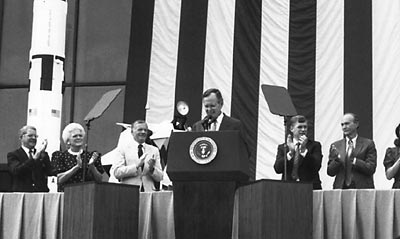The vision thingby Jeff Foust
|
| If there is little agreement about how to develop a vision, let alone what that vision should be, there is likely little chance of actually enacting any kind of compelling vision. |
After Apollo, though, there has not been a similar intersection of interests and incidents that had led to the development of a new vision for NASA and US space exploration. In the early 1970s NASA started on the space shuttle program, and in the 1980s started what would eventually become the International Space Station. Over time, these programs have evolved from means to certain ends—cheap, frequent space access for the shuttle, a base for wide-ranging scientific research and other work for the station—to ends in and of themselves. Neither was part of a well-defined, widely-accepted vision for space exploration. Only in the wake of the Columbia accident has NASA acknowledged that the shuttle is, and will always be, an experimental and no operational vehicle; the program faces a long and difficult road ahead to return the shuttle to flight. The station, meanwhile, is waiting on the shuttle so it can take the final steps towards the minimal “core complete” stage, far short of earlier, more grandiose plans. Combined, the shuttle and station act as a drag on NASA, programs mired in adversity but too difficult, and with too much invested in them, to easily discard.
The last time a President attempted to define a bold new vision for NASA was in 1989. President George H.W. Bush, speaking at ceremonies at the National Air and Space Museum marking the 20th anniversary of the Apollo 11 landing, promised a new spirit of exploration that would send humans back on the Moon—“this time, back to stay”—and on to Mars, all within 30 years. Most of what people remember about the Space Exploration Initiative (SEI) is the price tag NASA attached to the plan: $450 billion, or well over $600 billion in current dollars. That price quickly sank any hopes of making SEI a reality, and Bush made little effort to support or revive his initiative against Congressional opposition. Bush had much greater issues to grapple with at the time—the end of the Cold War, the first Gulf War, and a recession—none of which would be directly benefited by SEI.
Since then the biggest change in space policy was the incorporation of Russia into the space station program, an effort by the Clinton administration to engage the Russian aerospace industry in peaceful pursuits versus arms proliferation, and try to reap cost savings in the process. The last major overall space policy document issued by the White House was the National Space Policy of 1996. This document lays out the roles and responsibilities of NASA, the Defense Department, and other federal departments and agencies in space. The document is rational but uninspiring: the “goals” of the US space program, as defined in the policy, are deliberately vague, with few detailed metrics and deadlines by which to measure progress. One of the few things the document makes clear is that the human role in space is limited in the current policy to Earth orbit: “The International Space Station will support future decisions on the feasibility and desirability of conducting further human exploration activities,” it states.
Presidential plans
The Clinton-era space policy has survived nearly three years into the presidency of George W. Bush primarily through bureaucratic inertia. In the greater scheme of things, including a recession and war against terrorism in Afghanistan and Iraq, space is a relatively minor issue. It wasn’t until last year that the Bush administration convened an interagency panel to perform a “phased review” of national space policy. To date, that effort has led to only one published policy document, on commercial remote sensing, released in April. A second policy document on space transportation was nearly completed as of February 1, 2003, but put on hold in the wake of the Columbia accident; it still has not been completed, or at least not released.
| A recent report suggested that President Bush will make an announcement about a revised space policy on December 17, during the commemoration of the 100th anniversary of the Wright Brothers’ historic flight at Kitty Hawk, North Carolina. |
Sources within the administration have long said for months that review would go beyond remote sensing and space transportation to other topics, such as navigation, and eventually lead to an overall reassessment of space policy. Still, Congress was somewhat surprised in September when Sean O’Keefe, speaking at a hearing of the House Science Committee, mentioned that an interagency group was working on the future of US space policy out of public—and Congressional—view. The following week President Bush confirmed that such a review was in progress, but declined to provide any specifics. “I really don’t have an opinion on Mars,” the Houston Chronicle quoted Bush as saying, “but I do have an opinion that the more we explore, the better off America is.”
While this review takes place behind closed doors, there has been no shortage of rumors about their work. The latest report, published by SpaceRef.com on October 28, suggested that President Bush will make an announcement about a revised space policy on December 17, during the commemoration of the 100th anniversary of the Wright Brothers’ historic flight at Kitty Hawk, North Carolina. This new policy, the SpaceRef report claimed, would have an emphasis on resuming human missions to the Moon, developing the technology needed for more ambitious human missions to near-Earth asteroids and Mars.
